Shrimp lo mein is filled with juicy noodles, colorful veggies, and a savory-sweet sauce. Get ready to slurp up your dinner and quench those hunger pangs!
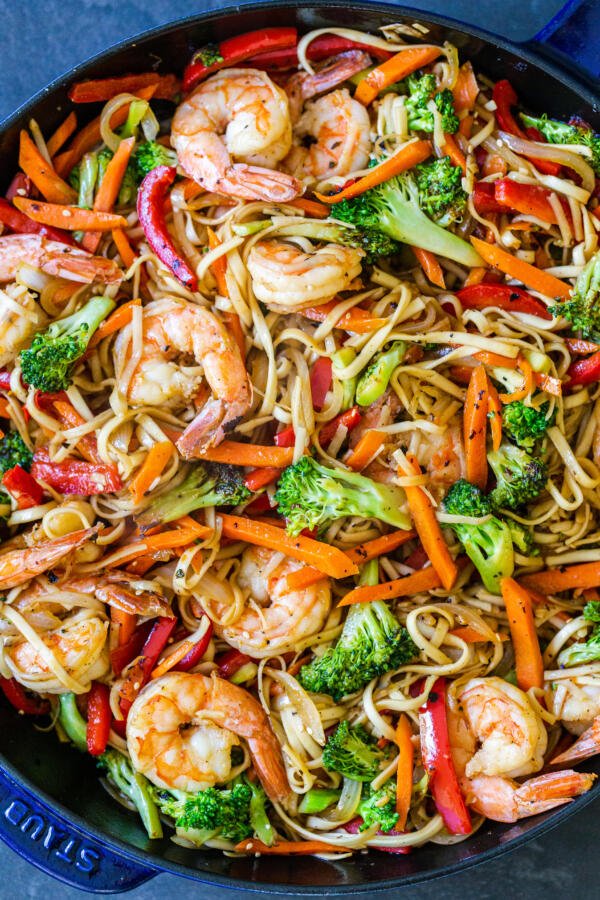
Hot tip: If you love lo mein, check out our veggie lo mein and beef lo mein too!
What Is Shrimp Lo Mein?
Shrimp lo mein is a popular Chinese takeout dish consisting of thick egg noodles tossed in a sweet and savory sauce. The sauce is made up of a delicious mix of brown sugar, soy sauce, and sesame oil. Often, a protein is added such as shrimp, chicken, or beef.
Lo mein is occasionally confused with “chow mein”, but the two dishes are different. Lo mein is made with soft noodles tossed in a rich and thick sauce, whereas chow mein has thinner, crunchier noodles tossed in a lighter sauce.
Hot tip: Not sure where to find lo mein noodles? They are typically found in the Asian or international food aisle at the grocery store. Or, pop into your local Asian specialty store for more authentic noodles.
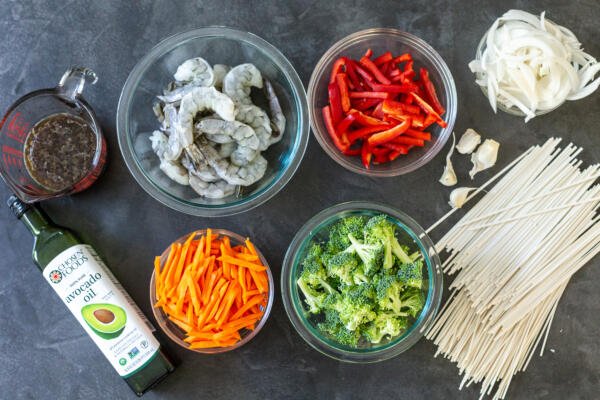
How To Make Shrimp Lo Mein
30 minutes and five easy steps — that’s what makes this easy shrimp lo mein recipe the best! The taste of happiness is just a noodle away.
- Make the lo mein sauce: Stir all the sauce ingredients together (except the soy sauce) in a small bowl until well combined. Then, add in the soy sauce and stir again.
- Cook the shrimp: In a hot skillet with sesame oil, cook the shrimp on both sides until they turn pink and develop a golden brown crust. Remove from the skillet and set aside.
- Sauté the veggies: Dice the veggies into two-inch pieces. In the same skillet, add more sesame oil and sauté the onions until golden brown. Remove, then sauté the carrots, followed by bell peppers and broccoli (cook all the veggies separately). Once all the veggies are cooked, return them back to the skillet and press in the garlic.
- Add the shrimp & sauce: Return the cooked shrimp to the skillet, then pour in the lo mein sauce and simmer for about two minutes.
- Toss in the noodles: Add the noodles and toss everything to combine. Cook another minute, then remove from the heat and enjoy!
Hot tip: To cut down on time, prep the veggies as you go (cut the next batch of veggies while the previous set cooks) and cook the noodles in the meantime.

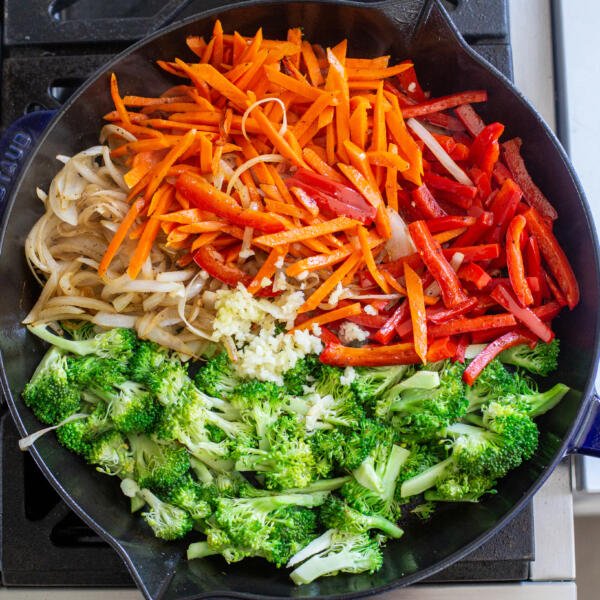

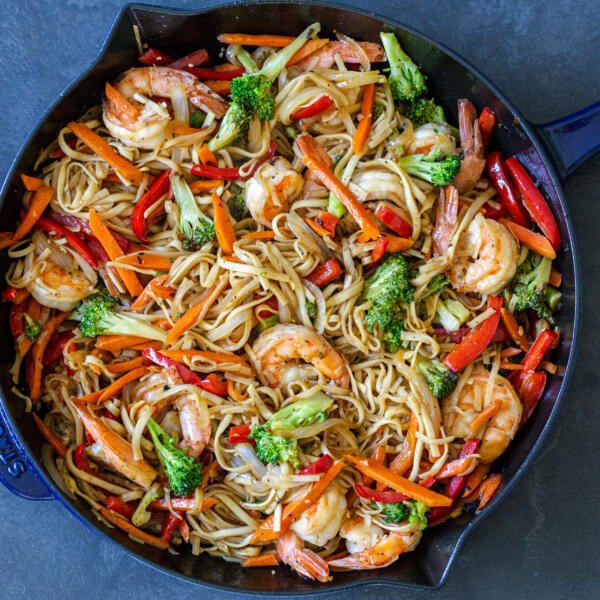
Veggie Additions
Lo mein, or any stir fry, is a great way to integrate loads of vegetables into your diet. For a super colorful dish, toss in as many different colors of veggies as you can! But — remember to cook the veggies separately to accommodate their different cook times.
- Green: Broccoli, Chinese broccoli, bok choy, green beans, sugar snap peas, snow peas, green onions, napa cabbage
- Beige: Water chestnuts, garlic (minced), mushrooms, bean sprouts
- Orange/Yellow: Carrots, orange/yellow/red bell peppers, baby corn
Hot tip: If you find yourself adding tons of additional veggies, make more lo mein sauce to compensate!
Tips for the Best Shrimp Lo Mein
Is it possible to make restaurant-quality shrimp lo mein from the comfort of your own kitchen? You bet it is! Follow these tips to make the stir fry noodle dish of your dreams.
- Substitute the noodles: Although lo mein noodles are the main ingredient, feel free to use spaghetti or linguine in a pinch. No matter which noodle you use, cook them according to package instructions. Boiling them for too long results in mushy noodles.
- Use a cast iron skillet or wok: For the best results, use a large skillet or wok to guarantee you’ll have enough room to toss the ingredients together.
- Layer the ingredients: It might be tempting to dump all of your ingredients in the pan at once, but in order for this dish to cook evenly, the veggies need to cook separately.
- Double the sauce (optional): If you love extra saucy, slurpy, and flavor-filled noodles, double the sauce! However, be careful with the soy sauce as too much can make the lo mein too salty. Even low sodium soy sauce still has salt, so swap a bit of the second portion of soy sauce with beef broth instead.
- Opt for sesame oil: It might feel natural for you to reach for olive oil, but sesame oil is best for stir frying because of its nutty flavor and high smoke point.
- Avoid overcooking the shrimp: Shrimp cook notoriously quick, so keep an eye on them. Remove the shrimp from the skillet as soon as they turn pink and take on a bit of a sear.
- Garnish it up: Chop up fresh green onions and sprinkle them on top right before serving. Add a sprinkle of sesame seeds if you’d like, too!

Serving Shrimp Lo Mein
Shrimp lo mein is a whole meal in itself — carbs, protein, and veggies. But what’s lo mein without a few Asian-inspired appetizers as well? If you love spring rolls, take your pick of either shrimp spring rolls or spring rolls with salmon. Or, if you want something crispy, check out these crab puffs. For a side dish to complement your lo mein, sweet and sour chicken or wonton soup make the perfect pairings.
Storing & Reheating Tips
This shrimp lo mein recipe makes about six servings, so if you find yourself with leftovers, it’s a win for you! Store them in the fridge or freezer, then reheat on the stovetop when ready to enjoy again.
- Refrigerator: Allow the leftover shrimp lo mein to cool completely, then transfer to an airtight container and store in the fridge for 3-4 days.
- Freezer: To store for 1-2 months, freeze the leftovers in a freezer-safe, airtight container. Thaw in the fridge overnight.
- Reheating: Reheat leftover shrimp lo mein in a skillet over medium heat. Add a splash of water to loosen up the lo mein sauce. Avoid overheating too much, as this may result in rubbery shrimp.
More Asian-Inspired Recipes
- Yakisoba Noodles – The Japanese version of lo mein, but with a different flavor
- Crazy Easy Shrimp Tempura — Japanese-style breaded and fried shrimp
- Beef Stir Fry – A great low-carb meal served with a steaming pile of white rice
- One Pan Beef and Broccoli — Beef, broccoli, and an irresistible sauce
Recipe
Ingredients
Lo Mein Sauce
- 1/4 cup hot water
- 1 tbsp Beef Better Than Bouillon
- 1 tsp sesame oil
- 2 tbsp brown sugar
- 3 tbsp soy sauce
Shrimp Lo Mein
- 8 oz lo mein noodles (cook according to package instructions)
- 1 lb shrimp (large with tail on)
- 1 large carrot
- 1 large bell pepper
- 2 cups broccoli
- 1 large onion
- 4 garlic cloves
- 3 tbsp sesame oil
Instructions
Lo Mein Sauce
- Combine the hot water, beef Better Than Bouillon, sesame oil, and brown sugar. Stir until the sugar is fully dissolved. Then, add soy sauce and set aside.
Shrimp Lo Mein
- Dice the carrots, bell pepper, broccoli, and onion into two-inch pieces.
- In a hot skillet with sesame oil, cook the shrimp on medium heat until they are just pink (about 3-5 minutes, depending on size). Remove from the skillet and set aside.
- In the same skillet, apply more sesame oil and sauté the onions until golden brown. Remove, then sauté the carrots until softened, followed by bell peppers, then broccoli. Add all the vegetables back to the skillet and press garlic into the mixture.
- Add the cooked shrimp into the skillet with the vegetables. Pour the lo mein sauce over the ingredients and simmer for about 2 minutes.
- Add the cooked noodles and toss everything together. Cook for another minute, then remove from the heat and enjoy!
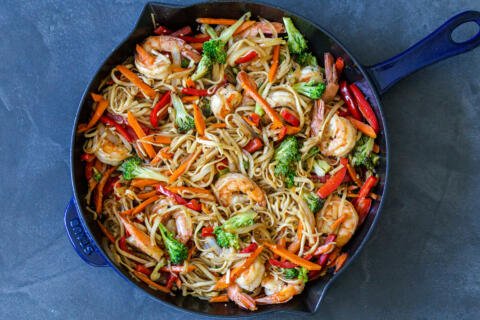
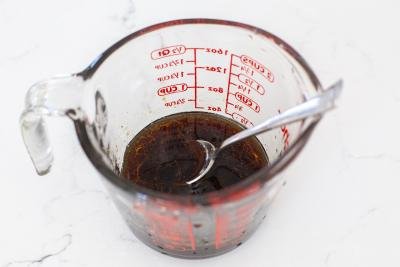
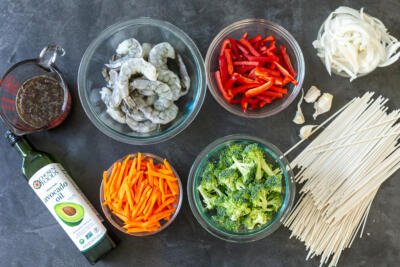
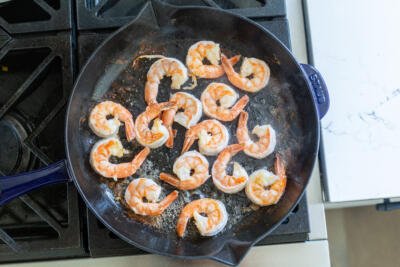
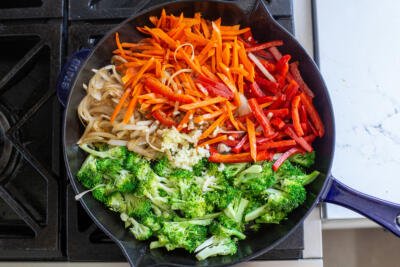
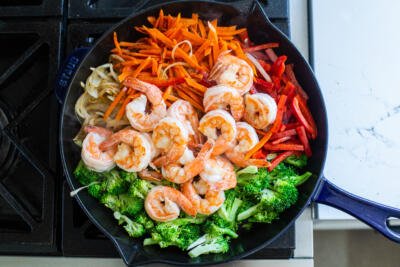
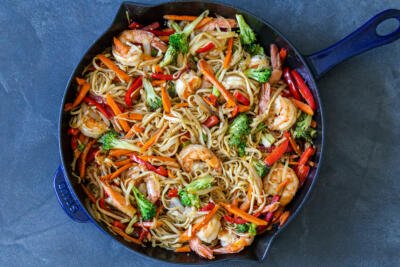
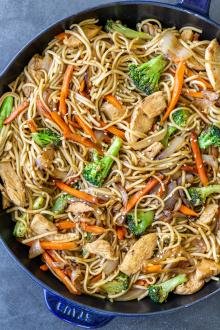
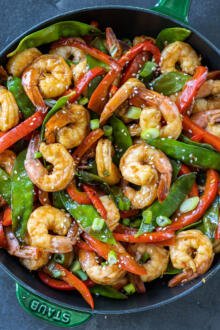
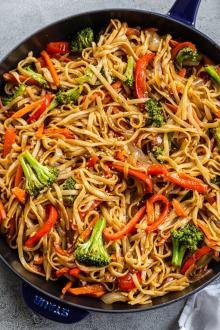
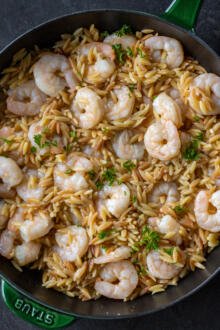
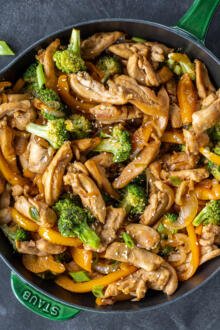
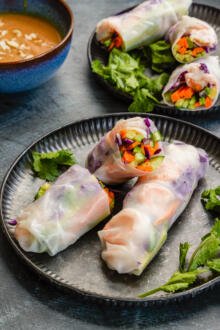
I also love sea food especially shrimp and lobster.
This is v good dish I will try it tomorrow morning.
Regards
Let me know how it goes, Farooq! Thanks for the comment 🙂
This recipe was so delicious 😋 thank you for the recipe my family really enjoyed it.
That's wonderful to hear! I'm so glad your family loved the recipe. I hope it'll be enjoyed many times again!
Oh Ma "GAUD"!!!!! I consider myself a "REALLY" GOOD Soul Food Cook. I had a Catering Service once, that was Requested for many many times. "BUT",,, I've tried and tried to make this, and it always turned out,,,okay. But I made it today, and it was "excellent"💯💯🤪🤪🤪🤪😋😋😋, THANK YOU SOOOOOO MUCH!!!!!👍🏾👊🏾👊🏾
Your enthusiasm just made my day! 🙂 I'm thrilled you found our recipe and from now on will always have the best Shrimp Lo Mein! Enjoy!
Fantastic recipe! absolutely delicious. My family loved every mouthful!! ❤️
Thanks for sharing Dianna! So happy the family loved it!
When I made this recipe, my preteen and teen told me that they loved it but wanted more broccoli! I have never had a request for more vegetables and was glad to oblige. I now add a total of 4 cups of broccoli (or a little more), and it turns out great. It might need more sauce, though, to go with the additional vegetables.
I also add a can of Chinese mixed vegetables (bean sprouts, bamboo shoots, water chestnuts, mushrooms) instead of carrots.
This recipe has made it into our regular rotation. Excellent recipe, thank you for sharing it!
I'm always happy to hear about teens welcoming more veggies into their meals! This made my day. Thanks for sharing Cathy!
Great recipe! The only substitute I made was green beans in place of broccoli. My mom said it tasted better than what you get at a Chinese restaurant. I thought the recipe sauce portion was enough especially since sautéing the shrimp and veggies in sesame oil gave added flavor. Thank you!
Hi Megan, I'm happy to hear you guys loved it! Enjoy!
This recipe was easy to make. I doubled the Lo Mein Sauce because we love saucy food. It was delicious, however, my husband and I found it to be too salty. It was edible but would have eaten more if not salty. Yes, I used low-sodium soy sauce and no other salt. Will try diluting the sauce with low-sodium beef broth when leftovers are reheated. Probably will not make it again. Thank you for sharing.
Hi Linda, I'm sorry to hear it was too salty. Perhaps the 6 tablespoons of soy sauce made it too salty? If you double the recipe again, try adding less soy sauce. I hope you'll give it another try!
hi' I've been replacing a lot of sugar in my recipes with honey do you think the brown sugar in this recipe can be substituted for honey
Ann
Hi Ann! Since it's part of the sauce, I think it could work- but I haven't tested it so I can't guarantee the results! Please let us know how it was if you try it.
My family loved it. Tripled sauce and added bag of coleslaw mix for carrots, also added can of baby corn and can of water chestnuts.
Marissa, thats such a great idea to add baby corn and water chestnuts. Thanks for sharing with us. I think it will be useful to others.
Made this tonight. Added sprouts, cabbage, bok choy, water chestnuts ,pea pods, Thai rice ,noodles double sauce. 10 pure 10. Served with homemade Lumpia.!
Hi Deb, thank you so much for sharing your process and feedback with me. It sounds like the Lo Mein turned out absolutely delicious!! Enjoy!
I really enjoyed this recipe. It was easy to make using basic ingredients and had excellent flavor. I did a few tweaks. I doubled the amount of noodles and quadrupled the amount of sauce. I did not have a bell pepper, but I added cabbage, bean sprouts, and water chestnuts. It was delicious. I will make it again. It seems very versatile with being able to switch up the different vegetables used.
Hi Suzanna, it sounds like this turned out absolutely delicious. Thank you for sharing your process and feedback with me. Enjoy it, dear!!
Cooking this tonight!!!!
Hi Arletta, I hope you love it! Let me know how it turns out!
Making this again Sunday. It will be my second time, this time adding chicken as well as shrimp (requested by the kiddos). Looking forward to each a delicious meal Sunday! Thank you for the recipe that is quick to make for a family of 11 ❤️
Hi Maria, So glad to hear this recipe was a hit! The added chicken sounds like it would be delicious! Thank you for sharing. Enjoy!
Making this tomorrow for Sunday dinner
Hello Nyree- enjoy! We love this dish so much! I hope you're doubling the recipe 😉
This turned out really really good! I doubled the sauce and added a little more beef bouillon and a little garlic salt to the veggies while they were cooking and it was amazing!
Thanks for the feedback, Dominique! 😀
EXCELLENT!!! I doubled this last night for my family of 4 so theoretically should serve 12. I figured even if some of us had second helpings, there should be enough for next night’s dinner. They gobbled it up and someone ate it during the night as well! Maybe one serving left. I will definitely make again and will always double it!
BTW, I only had onions and red bell pepper on hand (cooked together to save time) and used thin spaghetti noodles. Next time I’ll add more veggies. Great recipe!
Hi Diane- I'm so happy to hear you all loved it! This recipe is always a hit, and I'm surprised if theres ever leftovers, haha!
Based on all the reviews I am going to make this tonight (per recipe). Will let you know how it turns out. Have high hope as we do not have any quality Chinese restaurants around. Plenty of bad ones thought lol.
Ok, well my greatest fear in making this has come true. When I make something and it turns out really good, my wife does not want it anywhere except at home "sigh" This recipe is now going in our family cook book and saved on Pinterest as I am typing this, along with exactly what and how I did it. Mainly the vegetables I used as I stayed true to the recipe and will not make any changes. This was a grand slam and she has already told her parents about it after having the left overs today, which I might add were even better.
Hi Rob- thanks for updating us! So happy it was a hit for you guys! If you loved this recipe, try the beef lo mein as well. It's just as good!! 🙂
I Did, I made the shrimp for her and the beef for me, because I usually do not find the shrimp lo mien satisfying enough. Homemade and with this recipe, I could easily eat either and be happy.
Hi Rob- I hope you love it! This lo mein recipe is a hit for many. Enjoy!
Is There A Site On Utube Where I Can See. These Yummy Dishes Being Prepared With Ingredients And Store Options For Purchasing Ingredients. Any Suggestions Would Be Most Helpful…
Hi Tina - Hope you are well! Yes, you can visit our YouTube page for fun videos and tutorials. Find it here: https://www.youtube.com/user/…
Very tasty and I was even able to sneak in so many different types of vegetables for my picky family.
Couple of things that I did different that still worked. Used beef broth because I couldn't find what the recipe called for. Added baby bok choy and snow peas allow with the carrots and broccoli. Will probably add some mushrooms next time. Did have to add a little bit of cornstarch to the sauce to slightly thicken it. Also couldn't find egg noodles so used linguine instead which apparently works really well.
Definitely putting this recipe in the dinner rotation.
Hi Debbie, you're completely right lo mein is a great way to hide veggies and to get your whole family to eat them! I love all the additions you made, thank you for taking the time to comment and share them, I love hearing about all the variations people make to these recipes and how they make them work for their families!
Hi, I just wanted to thank you for sharing. I’ve made this multiple times and it’s a crowd pleaser! I don’t even order take out anymore. If I can make it myself goes on the list of things I won’t order take out for to help save money. Thanks again!
Hello, thank you very much for taking the time to comment. I am so glad you love the recipe, it really does save tons of money to make it homemade.
Could be good but next time will make changes. It is WAAAAAY too sweet. I doubled the sauce and would not double the sugar next time. Sauce needs something to thicken it. Directions say sesame oil is needed for the sauce but directions don’t mention it. If you’re new to cooking this recipe gives no time estimates for cooking anything.
Hey Paige, thank you for sharing your feedback. Lo Mein sauce is typically on a sweet side but your feedback would help those that don't like a sweet sauce. The sauce should thicken as you cook everything together. I hope you find a way to adjust it to your liking for the future. Thanks again!
This was so good! Tasted like takeout without all the greasy bad stuff
I am so glad you enjoyed the recipe, thank you for your feedback!
Hi! Is there any alternative to the beef bullion? Like beefj or chicken stock?
Hey, yes, you can always replace it with stock. I love the rich flavor of beef stock, it would be good here.
Have made this with shrimp, chicken and vegetables, so very good
I'm so glad you love the recipe, thank you for your feedback!
Delicious ! First attempt and was a big hit , thank you !
So glad you loved it, thank you for your feedback!!
The sauce itself is delicious, but even with double the sauce, the dish itself was not very flavorful. I'd likely need to make four times the amount of sauce. The total cook time was inaccurate. I was expecting this dish to be ready in 30 minutes, but instead it took me well over an hour. Next time, I would probably just cook the vegetable at once instead of doing them staggered. That is what took forever to cook.
Thank you for all of your feedback, Brittany, I'm glad that you enjoyed the shrimp lo mein!
Best lo mein recipe ever!! Made it twice in one week. Thanks so much for sharing the recipe!💕
I'm so glad the lo mein recipe turned out well and it that has become a staple, thank you for your feedback!
We had this for dinner tonight, and it was super yummy! Definitely making this again, many many times!! Super amazing 🙂
I'm so glad you enjoyed the recipe, thank you for your feedback!
I made this tonight and I like. It was very close to my favorite Chinese take out fine in restaurant. I say close because I should have made more sauce I think compared to the recipe I had double the noodles. I steamed my carrots for two minutes not sir fry on that. Added mushrooms, snow peas . Even so it is good, even without adding the extra sauce it was not bland, thank you darc
Hey Darcey, I am so happy to hear that you loved it. Yes, I would suggest adding more sauce if you add extra veggies tot he mix. Thank you for sharing this feedback!
I have to be soy free and I use Coco aminos. If sub soy sauce, should I omit the brown sugar, or cut back?
This would depend on your preference. I would add at least a little bit of it.